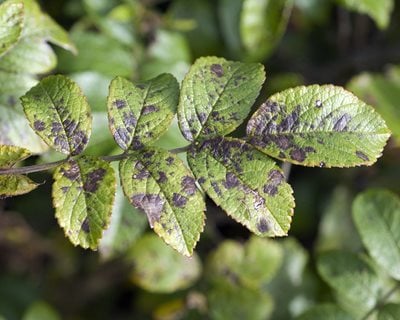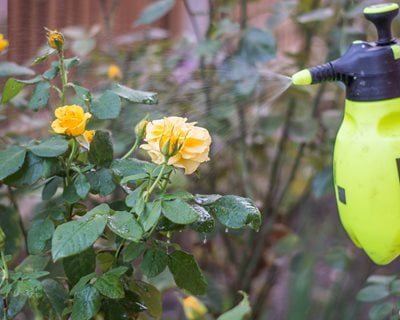How To Get Rid Of Black Spot On Roses

Photo by Manfred Ruckszio / Shutterstock.com
If rose growers had a public enemy number one, it would surely be black spot—a menacing fungal disease that poses a threat to roses. Once black spot disease begins attacking your roses, it can be very difficult to control and manage. Here are some tips for controlling black spot and how to minimize its impact on the health, beauty, and longevity of your plants.
On this page:
- What are the symptoms of black spot?
- What causes black spot?
- How to prevent black spot
- How to treat black spot
- How does black spot spread?
- Which roses are more susceptible to black spot?
- Which roses are more resistant to black spot?
WHAT ARE THE SYMPTOMS OF BLACK SPOT?
As the name implies, the first signs of black spot are irregularly shaped spots up to 1/2 inch in diameter, especially on the upper leaf surface. As the disease worsens, the leaves begin to yellow and eventually drop from the plant prematurely, usually beginning at the bottom and progressing upward. Over time, the entire plant may become defoliated and the canes can become infected as well.
WHAT CAUSES BLACK SPOT?
Like most fungal plant diseases, black spot (caused by the fungus Diplocarpon rosae) is brought on by a wet, humid environment and cool temperatures—conditions most likely to occur early in the growing season. If left unchecked, the loss of leaves can weaken your plants and inhibit bloom development.
Black spot usually won't kill your plants during the first year or two, but if it continues unabated, it will make them more susceptible to other diseases and unable to survive harsh winters.
HOW TO PREVENT BLACK SPOT
Black spot can be very difficult to control once it's well established. Here are a few things you can do to help prevent black spot from infecting your roses:
- Keep the foliage as dry as possible, since the spores need a wet surface in order to germinate.
- Avoid overhead watering, or water early in the day so the foliage has time to dry before nightfall.
- Improve the air circulation around your roses by spacing them properly and pruning them regularly.
- Grow your roses where they will receive ample sunlight, which speeds drying of the foliage.
If your roses do become infected, remove the diseased leaves and dispose of them. Also prune away and discard any infected canes. In the fall, remove all leaves and plant debris from your rose garden to prevent black spot from overwintering and returning in the spring, when new growth begins. Even a harsh winter won't kill spores that may be lying dormant in your garden.
Pro Tip: Denise Kelly of Variegata Studios also suggests spraying rose bushes with liquid kelp to make the cuticle of the leaf tougher, and therefore less susceptible.
HOW TO TREAT BLACK SPOT

Photo by Yulia Derid / Shutterstock.com
Once you see the telltale signs of black spot, you can't reverse the disease but you can stop the spread of infection to new leaves. The key to success for any treatment option is persistence:
- Start treating your roses early in the growing season.
- Respray them every week or two and after a heavy rain.
- Be sure to spray the entire plant, including the tops and bottoms of the leaves as well as the stems.
- Apply a dormant spray over winter to smother overwintering fungal spores.
Fungicide: There are a number of environmentally friendly organic products that do a good job at suppressing black spot, including sulfur, neem oil, and copper. Most products are available as foliar sprays or dusting powders and will control many types of fungal diseases.
Home remedies: In a pinch, you can formulate your own antifungal spray for treating black spot using ingredients commonly found in the kitchen. A Cornell University researcher demonstrated that a mixture developed for powdery mildew—1 tablespoon of baking soda mixed in a gallon of water, with a bit of horticultural oil or liquid soap added to help it cling to the leaves—is also effective for reducing the spread of black spot.
Some gardeners have reported varying degrees of success using sprays made of milk, vinegar, or hydrogen peroxide diluted with water. These homemade remedies may be worth a try, but we don't necessarily recommend them.
This publication from Purdue University Extension gives you tips for using organic fungicides and provides a list of commercially available products.
HOW DOES BLACK SPOT SPREAD?
Black spot spores are primarily spread from leaf to leaf and plant to plant by wind, but they won't germinate without the presence of moisture. That's why wet and humid conditions, especially over a prolonged period of time, are ideal conditions for black spot to take hold and spread freely.

Oso Easy Double Red™. Photo: Proven Winners.
GROW DISEASE-RESISTANT ROSES
If the thought of your roses becoming decimated by black spot (or other disease) sounds overwhelming, you don't have to forgo growing roses completely.
Oso Easy® landscape roses from Proven Winners are highly disease resistant and a great choice if you don't want to deal with the constant worry of diseases ruining your rose bushes. They also don't require any fussy pruning, so they're "Oso Easy" to grow!
WHICH ROSES ARE MORE SUSCEPTIBLE TO BLACK SPOT?
All types of roses are fair game for black spot, but some cultivars are much more susceptible than others. The roses most resistant to the disease include floribundas, shrub roses, and climbing roses, while the least resistant are hybrid tea roses, grandifloras, and miniature roses, according to University of Nebraska-Lincoln Extension. In general, rose bushes with dense foliage or those with leaves that grow close to the ground are more prone to infestation than roses with an open, airy canopy.
WHICH ROSES ARE MORE RESISTANT TO BLACK SPOT?
Often the best approach to eliminating black spot in the garden is to replace your most vulnerable roses with newer disease-resistant hybrids, advises Peter Kukileski, author of Roses Without Chemicals, which lists 150 rose varieties that excel in gardens without the use of pesticides. Disease-resistant roses are also less susceptible to other common fungal ailments, such as powdery mildew, rust, and anthracnose.
The degree of resistance can vary depending on plant care, site conditions, and the local environment, but in most cases your disease-resistant roses won't suffer much even if they do get black spot. "Some varieties of roses have a tendency that if they do get some black spot on their leaves, they won't defoliate. The genetics of the plant are strong enough to keep the leaves on the plant even with disease," says Kukileski.
RELATED:
How to Prune Roses
How to Get Rid of Powdery Mildew
How to Fertilize Roses
How To Get Rid Of Black Spot On Roses
Source: https://www.gardendesign.com/how-to/black-spot.html
Posted by: johnsgorry1949.blogspot.com

0 Response to "How To Get Rid Of Black Spot On Roses"
Post a Comment